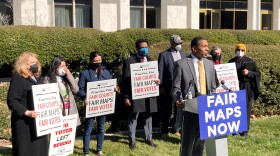When the smoke finally cleared from the Weaver Fertilizer Plant fire last winter, Winston-Salem officials turned their attention to helping those who were forced to pack their bags and head to safer ground. More than 6,500 people were under evacuation orders, many of whom lived in low-income neighborhoods.
So a relief fund was established to reimburse residents for expenses related to the crisis: food, shelter, lost wages – whatever was needed to get their lives back on track. The city tapped nonprofit Experiment in Self-Reliance (ESR), without a bid process, to manage the fund and hoped that the million dollars earmarked would be enough.
But one year later, a WFDD investigation has revealed that only $241,000 was distributed to just 656 residents. And ESR was paid $100,000 to do it.
“Shooting in the dark”
So what happened?
“We had never experienced anything like this in the city, nor had we established a relief fund ever,” said Assistant City Manager Patrice Toney, who oversaw the project. “So we were shooting in the dark at this.”
Toney says early on, they didn’t know a lot about how the fire affected people’s lives. They had to guess, and quickly – they wanted to provide relief to people who needed it as soon as possible.
So they pulled the trigger but didn’t set formal goals to measure success throughout the process.
“In terms of benchmarks, there really wasn't anything other than being able to bring people in to have interviews with the people within a one-mile radius, that was the requirement,” said Toney.
Over four months, money trickled out of the fund. Hundreds showed up for the community fair in March, but they had to return to ESR for an additional interview afterward. Officials say that process took longer than anticipated, and no other community fairs were scheduled.
The program wrapped in July with about two-thirds of the fund still remaining. Toney says that indicated to her that fewer people needed urgent help than initially estimated.
It’s a conclusion that Twana Roebuck, the executive director of ESR, came to as well. At a community meeting marking the one-year anniversary of the fire, Roebuck said she wasn’t sure if confusion about lawsuits was a factor too.
“I think the people that were interested in receiving our services came forth,” said Roebuck. “I think there was a mixed conversation in the community as it relates to if you were involved in a lawsuit, whether or not you could get help.”
What it costs to give away money

But what about those administrative funds – the money ESR was paid to distribute relief dollars to the community? Winston-Salem officials originally agreed on an 18% fee, which Toney says was higher than the city’s usual rate.
The final budget report shows it spent close to 30% of the project’s total costs on administrative expenses. Kate Van Tol, emergency management fellow at the University of North Carolina School of Government, says she hasn’t seen a rate that high in the nonprofit sector.
“There are some grants that will allow you to pay up to 20,” said Van Tol. “I don't really see anything above that. I would say a 10% fee is pretty standard.”
The contract was written to allow ESR to take an 18% cut of all funding it received from the city, no matter how much of it was actually distributed to people in need. In the end, that meant ESR got about $100,000.
“It could have just been an oversight in how the contract was written,” said Van Tol. “Generally, you're gonna have benchmarks, like once you reach this number of applicants we will release this amount of fee. And that is absolutely like personal contracting choices.”
When asked whether she would have written the contract differently had she known how much money would actually be distributed, Toney said no.
“No one likes to spend administrative costs,” she said. “I mean, at the end of the day, it's one of those necessary, don’t even want to call it evil, it’s just a necessary component in any operation.”
In an interview earlier this week, ESR Executive Director Twana Roebuck said that money was needed to get the right resources and people in place to distribute the funds.
“We had 16 caseworkers involved. I had a communications and development person, I had two finance people involved. And so just the people resources alone is one of the reasons why ESR is excellent in what we do,” said Roebuck. “And so I would tell the people that we were the right agency to listen and to be there for the residents at the time.”
Roebuck says she would be willing to reopen the fund if the city determines there’s interest.






